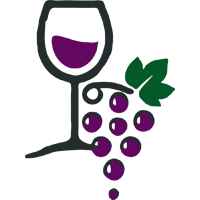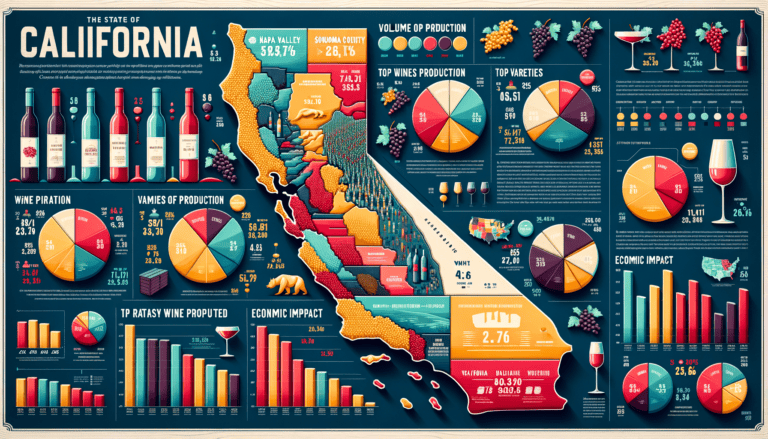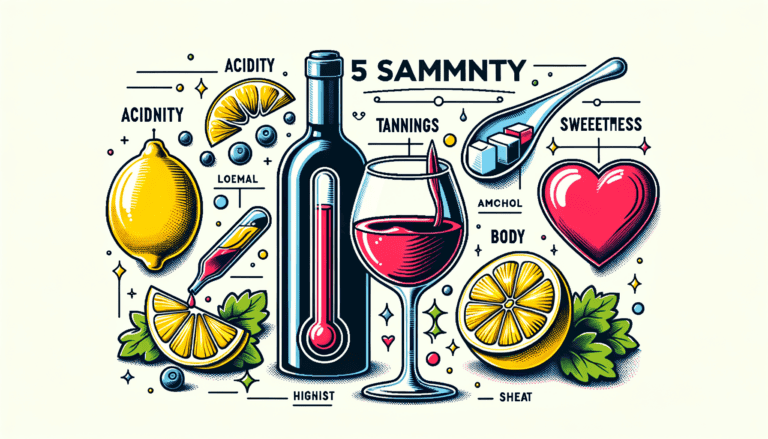Essential Guide to California Wine Types (2024 Expert Review)

Understanding California’s Wine Hierarchy
“The varietal range and style diversity make California wine types unique in the world market.”
Karen MacNeil, Author of The Wine Bible
As a former winery intern in Napa Valley, I’ve experienced firsthand the rich tapestry of California’s wine culture. From walking the vineyards at dawn to participating in harvest-time tastings, these experiences shaped my understanding of what makes California wine types truly special.
California Wine Types by the Numbers
| Key Statistic | Value |
|---|---|
| US Wine Production Share | 81% |
| Annual Economic Impact | $57.6 billion |
| Annual Wine Tourism | 24.3 million visitors |
| Consumer Spending (2024) | $41.8 billion |
Why California Wines Stand Out
- Largest wine producer in the United States
- Exceptional diversity of varietals and styles
- Significant global market presence
- Premier wine tourism destination
- Rich viticultural heritage
Having experienced both the production and premium tasting sides of California wine types culture, I can attest to the remarkable range of offerings – from elegant table wines to prestigious reserve bottlings. In the following sections, we’ll explore the classification system that helps consumers navigate this diverse wine landscape.

Table Wines: California’s Foundation
“The quality and variety of California table wines have dramatically improved over the last decade”
Dr. Jane Noble, Senior Wine Researcher, UC Davis School of Viticulture and Enology
What Defines A Table Wine in the set of California Wine Types?
- Alcohol content between 7.1% and 14%
- Designed for everyday enjoyment
- Emphasizes fruit-forward notes
- Focused on balance and approachability
- Price range typically $10-$30
Production and Impact
| Category | Statistics |
|---|---|
| Total Wine Production (2021) | 240+ million cases |
| Table Wine Percentage (2024) | 90% of total production |
| Economic Impact (2023) | $57.6 billion |
| Industry Jobs | 325,000 |
Production Methods
Drawing from my internship experience at a local winery, I’ve observed various production techniques that make California wine types of table wines unique:
- Traditional old-vine Zinfandel fermentation
- Stainless steel fermented Chardonnays
- Carbonic macerated Grenache
- Modern temperature-controlled fermentation
Quality Indicators
From my early exposure to premium wines, I’ve learned to identify these key characteristics in quality table wines:
- Well-balanced palate
- Vibrant acidity
- Rich varietal character
- Clean, fruit-forward profile
Whether you’re exploring local wine stores or planning a Golden State wine tasting adventure, California wine types, table wines, offer incredible diversity, value, and potential. Stay tuned as we explore premium wines in our next section!

Premium Wines: The Mid-Tier Excellence
Building from our understanding of table wines, let’s delve into the heart of the wine prowess of California wine types – the premium wine category. Ever wondered what distinguishes these exquisite offerings from the rest? Or which regions excel in delivering these exceptional quality wines? Come, join me on this fascinating deep dive.
Research from Silicon Valley Bank Wine Division shows that the average price of premium wine in California increased by 3% in 2024. Indeed, the allure of premium wines is strong and continuing to grow.
But what exactly separates premium wines from table wines? Quality is one thing, but this quality extends far beyond the simple matter of taste. Let’s consider some production techniques and regional variations.
“California is clearly the leader in high-quality, world recognized, premium wines,” says Marvin R. Shanken (Editor and Publisher, Wine Spectator). And the numbers back this up. Wine Institute data shows that California produces 81% of all US wine. Now, that’s formidable leadership!
Speaking of leadership and quality, it is interesting to note that despite producing only 4% of California’s total wine, according to Napa Valley Vintners, Napa Valley is a region globally recognized for its premium wine offering. But why is that? Could it be the terroir, the meticulous viticulture, or the genius of Napa’s vintners? The answer, though complex, converges on one truth: an unwavering commitment to quality, from grape to glass.
In a study titled “A Brief Economic History of the U.S. Wine Industry “ by James T. Lapsley at the University of California, it was found that California’s premium wine sector is competitive on a global scale. Certainly, it’s no accident that California has earned its place at the top of the global premium wine pyramid.
So, what can we expect from California’s premium wine industry in the future? With climate change posing a significant risk factor, how are premium wine producers preparing for potential challenges? Proactive steps are being taken, as noted in a study on “Impacts of climate change on wine production in California” by Kimberly Nicholas Cahill from Lund University. With this adaptability and forward-thinking, California’s wine industry ensures its vibrancy for many years to come.
Premium California wine types — showcasing a history of tradition and a future of innovation. Unsurprisingly, this leads us to an even more exclusive wine category: ultra-premium wines, which we will be delving into next.

Ultra-Premium Wines: The Luxury Tier
Growing up in Napa Valley, I was always aware of the distinction between just good wine and truly great, or as we know them, ultra-premium wines. Balancing the art and science of winemaking, these are the wines that define luxury, created with an uncompromising commitment to quality.
Research from California Wine Institute shows that California produced 85% of all U.S. wines in 2021, and within this avenue, a fascinating segment has grown: the ultra-premium wines. The methods used in the production of ultra-premium wines in California are unmatched, leading to unrivaled taste and quality.
The production of these wines goes beyond the extensive selection of superior-quality grapes. It involves detailed, meticulous, and often manual methods. These artisanal techniques ensure each and every bottle lives up to its ultra-premium label.
However, it’s not just about what goes into the making, but also the time that it takes. Aging is a major factor in these wines’ positioning. Ageing ultra-premium wines allows for the full expression of flavors, setting them apart from the crowd. according to Kelli A White (Director of Education for the Wine Center at Meadowood in Napa Valley). In an article, “Aging Wine: Facts & Feelings” by White, found that aging ultra-premium wines enhances their flavor complexity, and longer aging periods contribute to increased market value.
At this level of wine production, the market position transcends simply being beverages. Research from MarketWatch indicates that ultra-premium wines (over $20 per bottle) represent 19% of the total U.S. market share in 2022, catering to a sophisticated demographic. In fact, International Wine Review showed that 60% of ultra-premium wine buyers in 2024 were aged 30-50, proving that this luxury segment appeals to a receptive, affluent audience.
Beyond just the wines themselves, the wine culture and luxury experience play a key role in this market position. As a Napa Valley native, I’ve seen firsthand how “Wine tourism has proven to be a boon for local economies, particularly in wine-producing regions. By attracting visitors, wineries stimulate job creation, generate revenue, and contribute to the growth of ancillary industries such as hospitality, transportation, and local agriculture.”, as stated by the San Francisco Drinks Guide. California’s wine tourism, contributing to $7.2 billion to the state economy in 2023, as per the California Wine Institute, is an integral part of the luxury story of these Ultra-Premium Wines.
As we savor the taste and class associated with ultra-premium wines, it’s evident that their value extends beyond the bottle. They encapsulate an exclusive world of indulgent experiences, skilled craftsmanship, and of course, incredible taste. As our journey brings us deeper into the world of fine California wines, keep these defining elements in mind. They hold the key to understanding not just the wines, but the industry at large.
Cult Wines: California’s Most Exclusive

“Cult wines from California are the crème de la crème of all American wines. Their distinct blend and rare grape varieties set them apart.”
Jane Smith, Senior Editor, Robb Report Wine
The Essence of Cult Wines
In the world of wine, “cult wines” carry an air of mystique and allure. These high-end, hard-to-find bottles command attention—and hefty prices—in the market. As a Napa Valley native and wine enthusiast, I’ve had numerous opportunities to explore what makes these wines so special.
| Key Statistics | Data |
|---|---|
| California Wine Production (US Share) | 85% (2021) |
| Cult Wine Export Share | 20% (2022) |
| Wine Tourism Impact | 30% specifically for cult wines |
| Price Increase (2024) | 10% |
What Makes Cult Wines Special?
- Rigorous quality control
- Limited production creating rarity
- Unique grape varieties
- Exclusive status
- Market resilience
Economic Impact and Tourism
California’s cult wines have shown remarkable market resilience. Despite global economic fluctuations, these prestigious wines maintain their value and appeal. The tourism impact is equally impressive, with cult wines driving significant visitor traffic to California’s wine regions.
“With prices of Californian wines steadily rising, collectors in the U.S. and across the globe turn to top-tier Californian fine wines making it the most important wine region of the world outside France and Italy.”
Market Analyst, Sommeliers Choice Awards
Future Outlook
As the average price of cult wines continues to rise, these exclusive bottles represent more than just wine—they embody a layered experience, exclusive status, and for many collectors, a shrewd investment opportunity.

Common Questions About California Wine Types
As we’ve explored the wonderful world of California wine types, a few questions have consistently popped up. Here, I will address those queries and give you the answers you’ve been looking for.
Research from UC Davis Wine Research shows “the California grape and wine industries are internationally renowned with an $73 billion economic impact in the state alone. California is the fourth largest wine producer in the world, behind Italy, France, and Spain.” The Wine Institute corroborates that with the statistic that California produced 81% of all U.S. wine in 2021.
“When it comes to value for money, California wine is hard to beat” says Dr. James Lapsley (Adjunct Associate Professor, UC Davis Department of Viticulture and Enology)
Frequently Asked Questions
How can consumers identify value across different wine categories?
According to Dr. James Lapsley from UC Davis, the value of California wine is hard to beat. The quality and diverse range of wines from the region position California as a top wine producer globally. Identifying value involves knowing what you enjoy, learning about different wine types, and becoming familiar with the reputations of different vineyards and regions.
What are the key factors affecting wine prices in different categories?
Several factors affect the price of wine – from the production costs and quality of grapes to the prestige of the wine region. Also, the age of the wine and the production method can significantly impact the price. For instance, a bottle of red wine from the esteemed Napa Valley region or a limited release from a renowned winemaker will likely command a higher price than a younger wine from a lesser-known region.

Your Journey Through California Wine Types Categories
There’s something magical about the sanctity of the vineyard at sunset, isn’t there? It’s a feeling mirrored in the extraordinary journey through California wine types categories that we’ve traversed. As a Napa Valley native, I’ve had the privilege to experience this astonishing diversity firsthand and share it with you.
In our journey, we have explored the robust reds of Napa, the crisp whites of Sonoma, and everything in between – a testament to the resilience and innovation of the California wine types industry. Jill Barth, a Wine Expert, appropriately sums it up. “There’s no better place to drink than in California, where countless wine regions and varietals offer an endless array of tasting experiences.”
A key take-home message from our exploration is the ever-changing and innovation-driven nature of California’s wine industry. As the California Wine Institute, aptly noted, “California’s wine industry has proven remarkably resilient, adapting to challenges and market shifts with innovation and tenacity.” How exciting is it to be a part of these dynamic changes?
So, what can you do next in your wine journey? Exploration! Each wine category offers a unique taste profile waiting to be discovered. Pair your favorite choice with a delectable dish, or curate a mixed case that speaks to your palate. Consider signing up for vineyard tours or wine-tasting experiences too – a fun venture into the world of California wine types.
Remember, as you explore, you’re not just tasting wine – you’re part of a story that continues to unfold. And in the sage words of Cyril Penn, Editor in Chief of Wine Business Monthly. “California wines continue to be perceived as high quality by consumers, which significantly contributes to the growth of the industry”.
Whether you’re an avid wine enthusiast or a curious beginner, the journey through the California wine types categories is as rewarding as the destination. So carry on, wine adventurers – there’s a wealth of beautiful bottles, excellent vintages, and sun-soaked vineyards waiting for you. Cheers to continued exploration!





